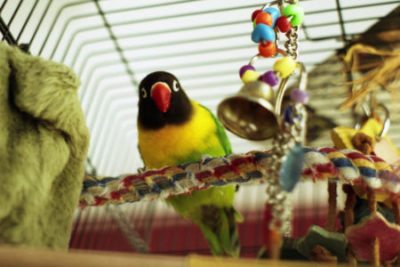Providing Enrichment for a Pet Bird
Birds make beautiful, entertaining, and intelligent pets. Caring for them can be rewarding, but also challenging, especially when it comes to keeping them mentally stimulated and energized.
With 20 years of experience as an aviary manager, Debra Turner, a senior research associate at the Texas A&M College of Veterinary Medicine & Biomedical Sciences, has advice on some of the most common and effective ways to provide enrichment for a pet bird.
Birds are typically happiest when given a variety of forms of enrichment, which could include toys, visual and auditory stimuli, and human interaction. Every bird is different, so it may take time to determine what yours is most curious about and entertained by.
“I have observed that different birds appreciate different types of toys,” Turner explained. “For instance, cockatoos are mechanically inclined and enjoy unscrewing stainless steel metal objects.”
For many birds, texture can be the factor that drives them to like or dislike certain toys. Turner said macaws tend to love shredding wood or paper, while cockatiels often prefer to play with plastic toys.
“Color is also an important factor to consider, as birds are very color-oriented; some birds might not appreciate a bright red object entering their environment,” she said.
In addition, noise can be a form of enrichment for many birds, especially when toys have features like bells, rattles, or crackly corn husks.
“The most important thing is safety,” Turner said. “Ensure lead-free, child-safe plastics for birds. Stainless steel is the safest option if metal is around the bird.”
She also advises choosing toys with Polyethylene rope instead of string because birds have been known to get tangled up in string and become trapped.
While plenty of colorful, interesting toys can be found online and at pet stores, owners also can consider creating homemade toys using safe materials and plenty of creativity. Simple objects like empty paper towel rolls, coffee filters, plastic Wiffle balls, and clean popsicle sticks can be connected with leather laces and sisal rope to make a variety of entertainment options.
Toys may be the most common form of enrichment, but a bird’s cage location can also have a big influence on the mental stimulation it experiences.
“In a house setting, cage placement should be near a window for outdoor viewing and sunlight,” Turner said. “If you wish to move the cage outside, if possible, ensure it is inside a second larger cage or screened area to protect from raptors and raccoons.”
Good airflow and partial shade are also necessary to protect a pet bird in an outdoor cage from the elements.
Birds can often be surprising in what gets them excited and energized. Some love to dance to certain music types and artists, while others prefer to play on a swing, and many enjoy watching other animals.
One of the easiest ways to provide a pet bird with enrichment is to give it attention and affection. Once a bird is trained and has come to trust its owner, both will enjoy getting to spend time together.
“The best enrichment one can give a bird is some time to interact in a positive manner,” Turner said. “Look up positive behavior training on the internet and the world will open up to you and your bird.”
Pet Talk is a service of the College of Veterinary Medicine & Biomedical Sciences, Texas A&M University. Stories can be viewed on the web at vetmed.tamu.edu/news/pet-talk. Suggestions for future topics may be directed to editor@cvm.tamu.edu.


